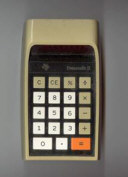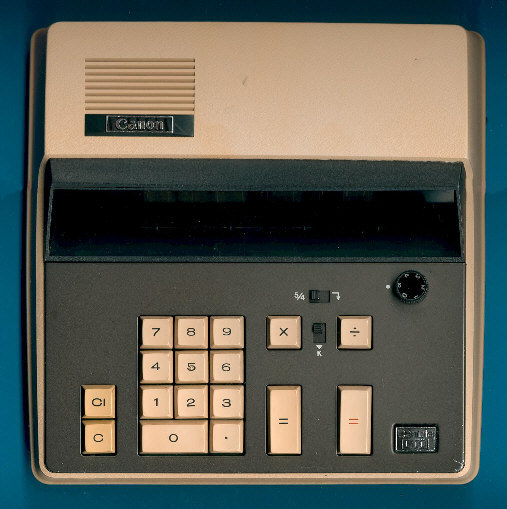
DATAMATH CALCULATOR MUSEUM
 |
DATAMATH CALCULATOR MUSEUM |
Canon Canola L100
| Date of introduction: | 1971 | Display technology: | Panaplex tubes |
| New price: | Display size: | 10 | |
| Size: | 9.7" x 9.2" x 2.7" | ||
| Weight: | 4 pounds 11 ounces | Serial No: | 200357 |
| Batteries: | n.a. | Date of manufacture: | year 1971 |
| AC-Adapter: | 220V | Origin of manufacture: | Japan |
| Precision: | 10 | Integrated circuits: | TMC1737, TMC1753, TMC1754, TMC1807 |
| Memories: | |||
| Program steps: | Courtesy of: | Joerg Woerner |
 The
Canon Canola L100 preceded the first desktop calculator manufactured by Texas
Instruments - the TI-3000 - about one
and a half year.
The
Canon Canola L100 preceded the first desktop calculator manufactured by Texas
Instruments - the TI-3000 - about one
and a half year.
![]() Instead
of the later single-chip calculator electronics found in
the TI-3000 and its sibling TI-3500
the L100 uses four chips similar to the Pocketronic. A similar architecture
could be found in the even larger desktop calculators L121 and L160, too.
Instead
of the later single-chip calculator electronics found in
the TI-3000 and its sibling TI-3500
the L100 uses four chips similar to the Pocketronic. A similar architecture
could be found in the even larger desktop calculators L121 and L160, too.
![]() The display
consists of 10 single tubes with a 7-segment layout. Later products like the L100A
or L100S used a construction similar to the Panaplex™
display manufactured by
Burroughs.
The display
consists of 10 single tubes with a 7-segment layout. Later products like the L100A
or L100S used a construction similar to the Panaplex™
display manufactured by
Burroughs.
In Texas Instrument's history of calculator chips the L100
plays an important role. It adds to the three LSI-circuits (Arithmetic Chip, Entry
Chip,
and Data Chip) of the Pocketronic
an additional Display Chip.
Please compare the quick evolution of the calculator technology:
| Type | Year | Digits | Chip set |
| L100 | 1971 | 10 | TMC1737, TMC1753, TMC1754, TMC1807 |
| L100A | 1971 | 10 | TMS1824, TMS1825 |
| L100S | 1972 | 10 | TMS0106 single chip |
| L121F | 1972 | 12 | TMS0201, TMS0302 |
The next desktop calculator in Canon's line was the L100A
using the TMC1824, TMC1825 chips of the LE-10.
If you have additions to the above article please email: joerg@datamath.org.
© Joerg Woerner, December 21, 2001. No reprints without written permission.